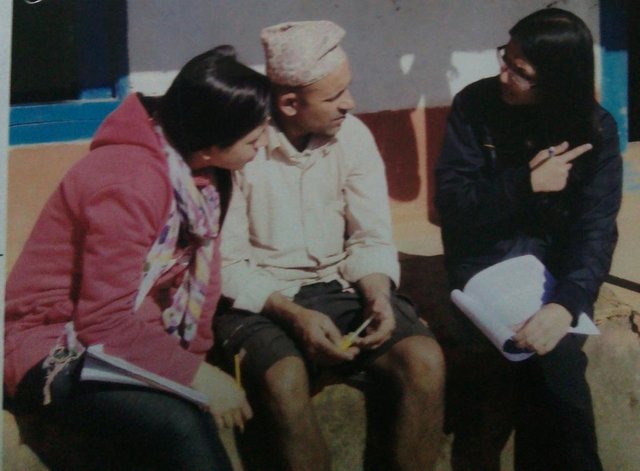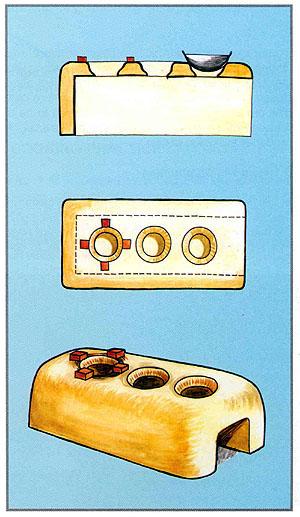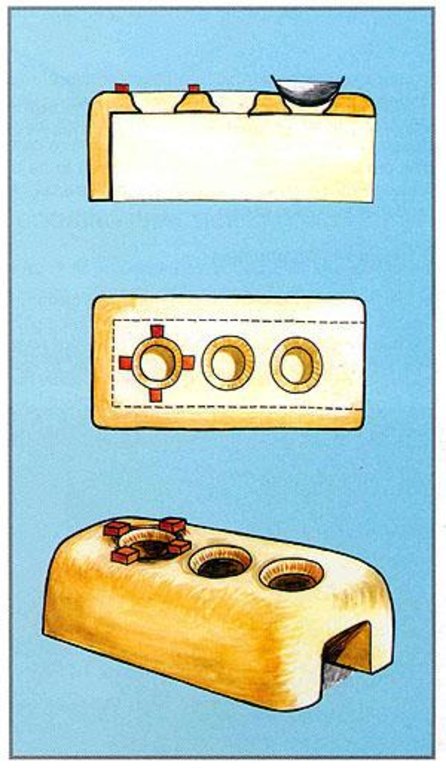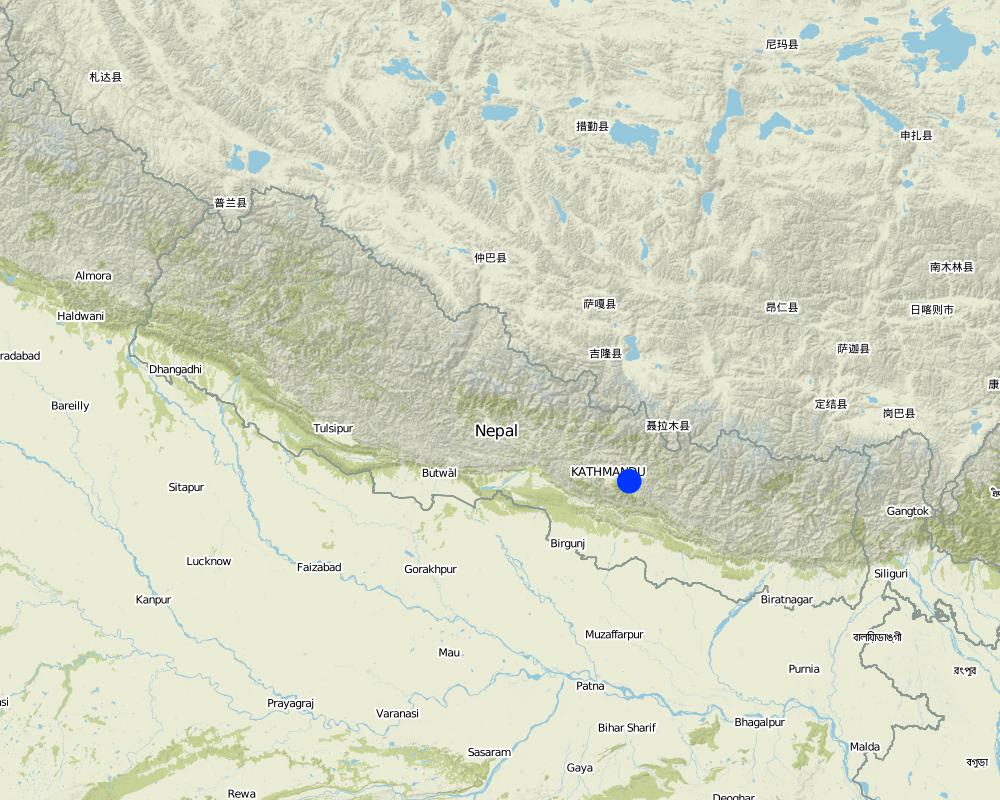Khuwa making by the use of Improved stove [Nepal]
- Creation:
- Update:
- Compiler: Sabita Aryal
- Editor: –
- Reviewers: David Streiff, Alexandra Gavilano
Khuwa utpadan ma sudhariyeko chulo (in nepali)
technologies_1233 - Nepal
View sections
Expand all Collapse all1. General information
1.2 Contact details of resource persons and institutions involved in the assessment and documentation of the Technology
SLM specialist:
Shrestha Niroj
Kathmandu University
Nepal
SLM specialist:
Gyawali Richa
Kathmandu University
Nepal
SLM specialist:
Bhandari Aastha Singh
Kathmandu University
Nepal
Ghimire Somnath
Nepal
Name of the institution(s) which facilitated the documentation/ evaluation of the Technology (if relevant)
Kathmandu University (KU) - Nepal1.3 Conditions regarding the use of data documented through WOCAT
The compiler and key resource person(s) accept the conditions regarding the use of data documented through WOCAT:
Yes
1.5 Reference to Questionnaire(s) on SLM Approaches (documented using WOCAT)

Khuwa Production and Marketing in Chyamrangbesi [Nepal]
This SLM Approach deals with the making of Khuwa (dairy product base), using traditional as well as improved methods and further its supply and marketing.
- Compiler: Sabita Aryal

Chyamrangbesi - A smoke free zone by using … [Nepal]
The ways and means used to promote and implement to improved stove to improve human well-being and sustainable land use.
- Compiler: Sabita Aryal
2. Description of the SLM Technology
2.1 Short description of the Technology
Definition of the Technology:
The technology used is improved stove. An improved stove is a device that is designed to consume less fuel and save cooking time,convenient in cooking process and creates smokeless environment or reduction in volume of smoke against the traditional stove.
2.2 Detailed description of the Technology
Description:
Technology used is improved stove. Improved stove is more efficient to use than traditional stove. Efficient in the sense that it consumes less fire wood (half than that consumed by traditional stove). It consists of one input hole to feed the wood and the heat is transferred throughout the stove which saves the firewood consumption. There is a hole for the passage of smoke.
Purpose of the Technology: The main purposes of this technology are:
•Increased thermal efficiency
•Conservation of forests by cutback in firewood conservation
•Reduction in indoor air pollution and hence smoke released health disorders
•Prevention of fire hazards
•Reduction of cooking time
Establishment / maintenance activities and inputs: The factory for khuwa production was established in 2050 BS. It is continued from their ancestors. In ancient time, for the production large amount of firewood was needed and from this large amount of smoke was released which gave rise to health problems and environmental pollution.
Now, the technology has changed but the process is still the same. Improved stove is used instead of traditional stove. For the improved stove materials required are soil, iron rod & tin. Other tools and utensils are dabilo,khurpi, karai & bowl. Monthly maintenance is required.
Natural / human environment: This technology is environment friendly. This technology has direct effect on the agro forestry sector, rural economy and health.
2.3 Photos of the Technology
2.5 Country/ region/ locations where the Technology has been applied and which are covered by this assessment
Country:
Nepal
Region/ State/ Province:
Nepal
Further specification of location:
Kavrepalanchowk,Chyamrangbesi VDC
Specify the spread of the Technology:
- applied at specific points/ concentrated on a small area
Comments:
Total area covered by the SLM Technology is 28-97 m2.
There are altogether 17 factories for the production of khuwa. Combinely the technology is implemented n 1-10 km2.
Map
×2.6 Date of implementation
If precise year is not known, indicate approximate date:
- 10-50 years ago
2.7 Introduction of the Technology
Specify how the Technology was introduced:
- through land users' innovation
Comments (type of project, etc.):
established in 2050 BS.
3. Classification of the SLM Technology
3.1 Main purpose(s) of the Technology
- Increases efficiency
3.2 Current land use type(s) where the Technology is applied

Settlements, infrastructure
- Settlements, buildings
Comments:
Major land use problems (compiler’s opinion): Air pollution from the smoke
Major land use problems (land users’ perception): He says that there is no pollution.
Forest products and services: fuelwood
3.4 Water supply
Water supply for the land on which the Technology is applied:
- full irrigation
3.5 SLM group to which the Technology belongs
- energy efficiency technologies
3.6 SLM measures comprising the Technology

structural measures
- S11: Others

management measures
- M7: Others
Comments:
Main measures: structural measures
Secondary measures: management measures
3.7 Main types of land degradation addressed by the Technology

biological degradation
- Bq: quantity/ biomass decline
Comments:
Main causes of degradation: deforestation / removal of natural vegetation (incl. forest fires) (requirement of wood as firewood), change in temperature (increase in temperature due to burning of firewood), inputs and infrastructure: (roads, markets, distribution of water points, other, …) (problems due to transportation, market unavailablity)
Secondary causes of degradation: release of airborne pollutants (urban/industry…) (smoke from firewood), poverty / wealth (people are poor), labour availability (provides employment opportunity to local people)
4. Technical specifications, implementation activities, inputs, and costs
4.1 Technical drawing of the Technology
Technical specifications (related to technical drawing):
Fig(1) shows the orthographic and isometric view of improved stove.
Location: Chyamrangbesi. Kavre
Date: 15th Jan 2012
Technical knowledge required for field staff / advisors: high (labour is needed for utilizing the technology)
Technical knowledge required for land users: high
Main technical functions: increase in organic matter
Secondary technical functions: increase in nutrient availability (supply, recycling,…)
Structural measure: hole for smoke passage
Structural measure: 1 m iron rod to support stove
Construction material (earth): The improved soil is made up of soil or mud.
Construction material (other): Iron rod is used to support the stove and tin is used to build chimneys.
Layout change according to natural and human environment
4.2 General information regarding the calculation of inputs and costs
Specify how costs and inputs were calculated:
- per Technology unit
Specify unit:
improved stove
Specify currency used for cost calculations:
- USD
If relevant, indicate exchange rate from USD to local currency (e.g. 1 USD = 79.9 Brazilian Real): 1 USD =:
-1.0
4.3 Establishment activities
| Activity | Timing (season) | |
|---|---|---|
| 1. | Labour | Monthly |
| 2. | Construction of improved stove | once |
| 3. | Instrument/cost of the tools | once |
| 4. | construction of hole for passage of smoke | once |
4.4 Costs and inputs needed for establishment
| Specify input | Unit | Quantity | Costs per Unit | Total costs per input | % of costs borne by land users | |
|---|---|---|---|---|---|---|
| Labour | Labour | unit | 1.0 | 68.98 | 68.98 | 100.0 |
| Equipment | Stove and tools | unit | 1.0 | 284.09 | 284.09 | 100.0 |
| Total costs for establishment of the Technology | 353.07 | |||||
| Total costs for establishment of the Technology in USD | -353.07 | |||||
4.5 Maintenance/ recurrent activities
| Activity | Timing/ frequency | |
|---|---|---|
| 1. | Stove | monthly |
| 2. | Labour for repairing stove | monthly |
4.6 Costs and inputs needed for maintenance/ recurrent activities (per year)
| Specify input | Unit | Quantity | Costs per Unit | Total costs per input | % of costs borne by land users | |
|---|---|---|---|---|---|---|
| Labour | Reparing stove | unit | 1.0 | 3.44 | 3.44 | 100.0 |
| Total costs for maintenance of the Technology | 3.44 | |||||
| Total costs for maintenance of the Technology in USD | -3.44 | |||||
4.7 Most important factors affecting the costs
Describe the most determinate factors affecting the costs:
Milk fat determines the cost of the milk.Transportation fee, labor cost & distribution of khuwa(milk products) affect the cost.
5. Natural and human environment
5.2 Topography
Slopes on average:
- flat (0-2%)
- gentle (3-5%)
- moderate (6-10%)
- rolling (11-15%)
- hilly (16-30%)
- steep (31-60%)
- very steep (>60%)
Landforms:
- plateau/plains
- ridges
- mountain slopes
- hill slopes
- footslopes
- valley floors
Altitudinal zone:
- 0-100 m a.s.l.
- 101-500 m a.s.l.
- 501-1,000 m a.s.l.
- 1,001-1,500 m a.s.l.
- 1,501-2,000 m a.s.l.
- 2,001-2,500 m a.s.l.
- 2,501-3,000 m a.s.l.
- 3,001-4,000 m a.s.l.
- > 4,000 m a.s.l.
5.6 Characteristics of land users applying the Technology
Market orientation of production system:
- mixed (subsistence/ commercial)
- commercial/ market
Relative level of wealth:
- poor
- average
Individuals or groups:
- individual/ household
Gender:
- men
Indicate other relevant characteristics of the land users:
Land users applying the Technology are mainly common / average land users
Difference in the involvement of women and men: Women are involved with the household chores and people say that women cannot do such works.
Annual population growth: > 4%; 5%
65% of the land users are average wealthy and own 70% of the land (mostly the land users who apply the SLM technology).
35% of the land users are poor and own 30% of the land (some are poor).
Market orientation of production system: Commercial/ market (milk product is sent to the market,so it is commercial), only few production are used are used subsistence (self-supply)
5.7 Average area of land used by land users applying the Technology
- < 0.5 ha
- 0.5-1 ha
- 1-2 ha
- 2-5 ha
- 5-15 ha
- 15-50 ha
- 50-100 ha
- 100-500 ha
- 500-1,000 ha
- 1,000-10,000 ha
- > 10,000 ha
Is this considered small-, medium- or large-scale (referring to local context)?
- medium-scale
5.8 Land ownership, land use rights, and water use rights
Land ownership:
- individual, not titled
Land use rights:
- individual
Comments:
only the owner have the right.
6. Impacts and concluding statements
6.1 On-site impacts the Technology has shown
Socio-economic impacts
Production
wood production
risk of production failure
product diversity
production area
land management
Water availability and quality
drinking water availability
drinking water quality
water availability for livestock
water quality for livestock
irrigation water availability
irrigation water quality
demand for irrigation water
Income and costs
expenses on agricultural inputs
farm income
diversity of income sources
workload
Socio-cultural impacts
livelihoods and human well-being
Comments/ specify:
By improved stove the consumption of wood and production of smoke has been decreased to a great extent which decreases the chance of getting negative impact from the smoke in human health and environment.
6.3 Exposure and sensitivity of the Technology to gradual climate change and climate-related extremes/ disasters (as perceived by land users)
Gradual climate change
Gradual climate change
| Season | increase or decrease | How does the Technology cope with it? | |
|---|---|---|---|
| annual temperature | increase | not well |
Climate-related extremes (disasters)
Meteorological disasters
| How does the Technology cope with it? | |
|---|---|
| local rainstorm | not known |
| local windstorm | not well |
Climatological disasters
| How does the Technology cope with it? | |
|---|---|
| drought | not known |
Hydrological disasters
| How does the Technology cope with it? | |
|---|---|
| general (river) flood | not known |
Other climate-related consequences
Other climate-related consequences
| How does the Technology cope with it? | |
|---|---|
| reduced growing period | not well |
| seasonal changes | not well |
Comments:
concrete improved stove can be made in order to improve the tolerance than soil improved stove.
6.4 Cost-benefit analysis
How do the benefits compare with the establishment costs (from land users’ perspective)?
Short-term returns:
neutral/ balanced
Long-term returns:
neutral/ balanced
6.5 Adoption of the Technology
Comments:
There is a strong trend towards spontaneous adoption of the Technology
Comments on adoption trend: this technology has been used by 17 land user and this technology is increasing in practice.
6.7 Strengths/ advantages/ opportunities of the Technology
| Strengths/ advantages/ opportunities in the land user’s view |
|---|
|
less consumption of wood How can they be sustained / enhanced? they can be enhanced by using modern machine which operates by electricity. By this there would be no pollution. |
| pollution reduction |
| ashes after burning firewood can be used as organic matter for soil |
| Strengths/ advantages/ opportunities in the compiler’s or other key resource person’s view |
|---|
| low cost, local availability and easy to manufacture |
| reduced concentrations of smoke and indoor air pollution |
| saves time and money in acquiring fuel |
| less pressure on forest and energy resources |
6.8 Weaknesses/ disadvantages/ risks of the Technology and ways of overcoming them
| Weaknesses/ disadvantages/ risks in the compiler’s or other key resource person’s view | How can they be overcome? |
|---|---|
| monthly repairing is required | Implement new technology i.e. use machine that runs by electricty |
7. References and links
7.1 Methods/ sources of information
Links and modules
Expand all Collapse allLinks

Khuwa Production and Marketing in Chyamrangbesi [Nepal]
This SLM Approach deals with the making of Khuwa (dairy product base), using traditional as well as improved methods and further its supply and marketing.
- Compiler: Sabita Aryal

Chyamrangbesi - A smoke free zone by using … [Nepal]
The ways and means used to promote and implement to improved stove to improve human well-being and sustainable land use.
- Compiler: Sabita Aryal
Modules
No modules





